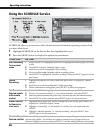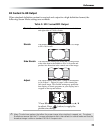
References
73
References
In this section you will find frequently asked questions and troubleshooting, product
specifications, license agreements and the limited warranty.
Learning About Available Video Services
Your HD DVR can receive a variety of programs and make them available to you on your schedule.
The HD DVR can receive signals from both an antenna and from a cable TV service provider.
Receivable signals from an antenna include both analog and digital broadcasts. Digital broadcasts
may be available in either standard-definition (SD) or high-definition (HD) formats. Cable TV
services that can be received include analog cable (unscrambled), unencrypted digital cable and
encrypted digital cable. Reception of encrypted digital cable services requires the use of a
CableCARD™ device. Contact your cable TV service provider for information about the availability
of SD or HD services, unencrypted digital cable services and CableCARD services.
Analog signals are the conventional type that have been available for decades. Standard
characteristics of an analog signal are 4:3 aspect ratio (an almost square image screen), with a native
resolution (picture quality) of 640 x 480, active lines interlaced scanning of 480 lines per screen, and
stereo or mono sound.
Digital signal formats and the digital picture quality (resolution) are classified into the following
three categories: High-Definition (HD), Enhanced Definition (ED) and Standard Definition (SD). Your
HD DVR is classified under the High-Definition category. Your connections should reflect the best
possible picture quality available with your equipment. This will allow you to take best advantage of
your HD DVR. You will receive digital signals through the HD DVR and view programs on your TV.
Cable TV Services
Analog
Digital Unencrypted (SDTV or HDTV)
Digital Encrypted (with a CableCARD, SDTV or HDTV)
Broadcast Signals
Analog
Digital (SDTV or HDTV)


















